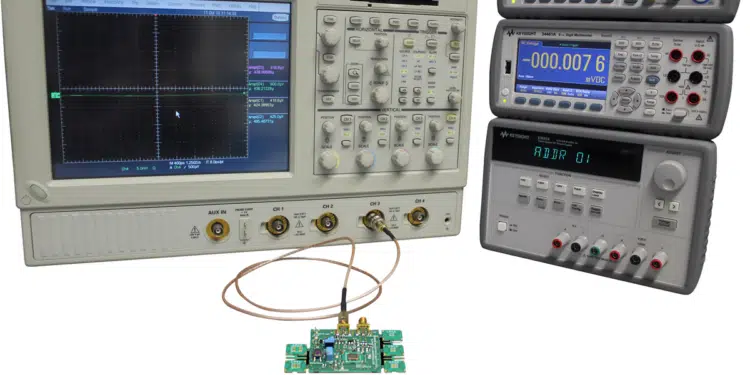The desire to be able to test oscillators quickly and easily is more than achievable using the IOSC EVBoard. The evaluation board is suitable for measuring most surface mount standard oscillators, VCXOs or TCXO/VCTCXOs. It is available from IQD, part of the Würth Elektronik eiSos Group, and a selection of distributors.
The IOSC EVBoard comes with six smaller boards that can be snapped off the main board and onto which different sized 4-pad oscillators can be soldered. The smaller board can then be soldered to the main board. The six different package sizes are 1.6 x 1.2 mm, 2.0 x 1.6 mm, 2.5 x 2.0 mm, 3.2 x 2.5 mm, 5.0 x 3.2 mm and 7.0 x 5.0 mm.
Since noise in the supply voltage can affect the frequency of the oscillator, the IOSC-EVBoard contains a regulated and filtered supply voltage. It can be freely selected between 1.8 V and 5.0 V. This allows the performance of the oscillator to be considered under ideal conditions. However, it may also be necessary to deliberately introduce noise during testing to observe the consequences. For this purpose, the IOSC EVBoard also offers the option to connect a supply voltage directly.
The Enable/Disable function can be tested by manual switching to observe the effect on current draw. In addition, there is the possibility to set this input to “high” or “low” via a digital source to measure the enable time. For products with voltage control input such as VCXOs and VCTCXOs, the board includes a potentiometer to bring the frequency tolerance and the effect of soldering back to the nominal frequency by pulling. This process can further be used to manually adjust the control voltage to simulate the effect on frequency. For sensitive products like VCTCXOs, in addition to pulling the frequency, there is the possibility to replace the applied potentiometer resistor by a fixed resistor. This leads to better stability and optimized jitter as well as phase noise. Of course, the pull input can also be fed via an external analog source.
For the output signal the IOSC-EVBoard offers three configurations. Here you can choose between a CMOS output, a clipped sine or a direct output without buffer or load. All outputs are terminated in an SMA connector.
The evaluation board is available in two options – as an unpopulated PCB supplied with the appropriate bill of materials and as a populated board for immediate use. The unpopulated version is currently available free of charge from IQD with the next 200 oscillator sample orders – It pays to be quick!
































